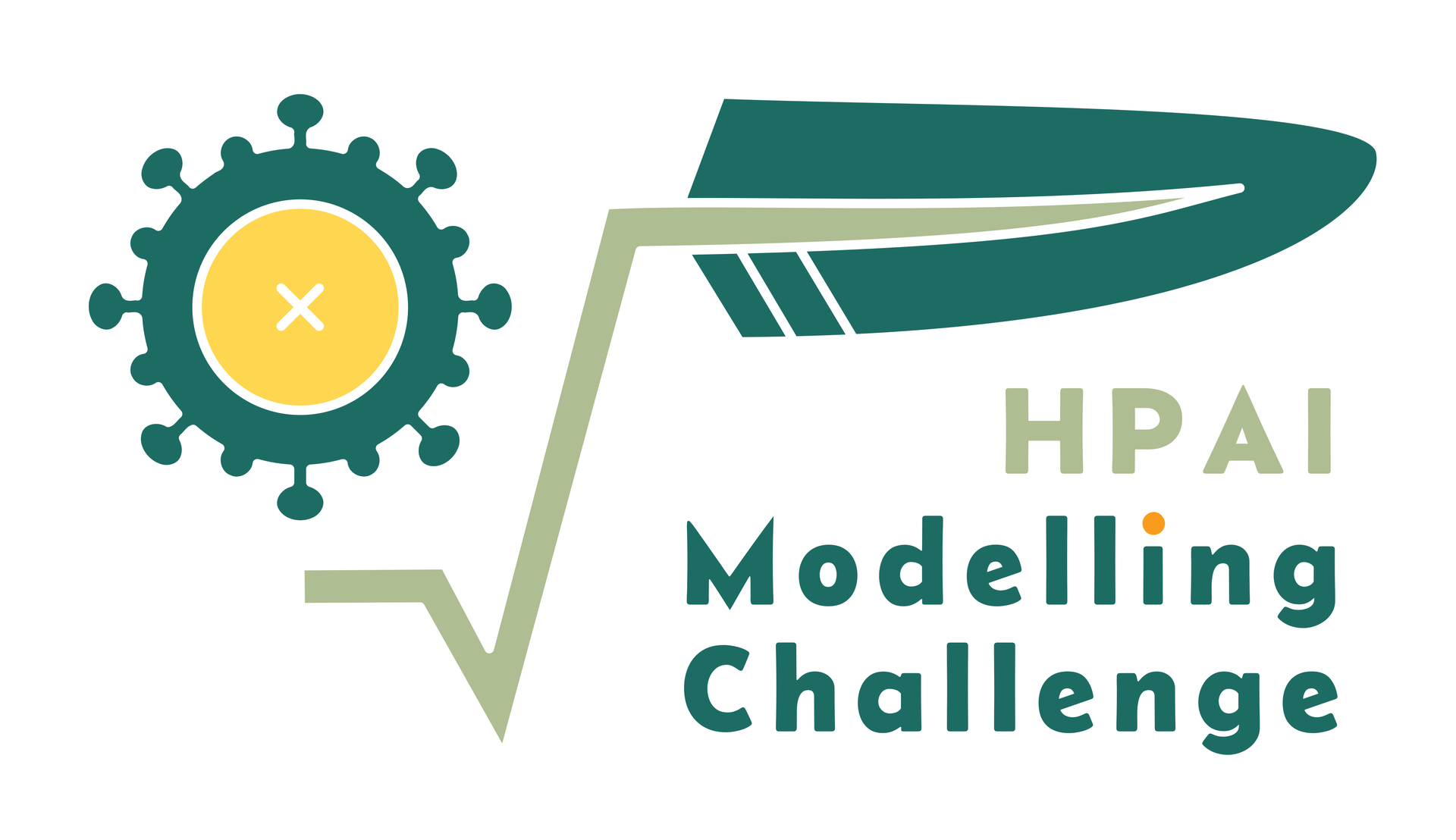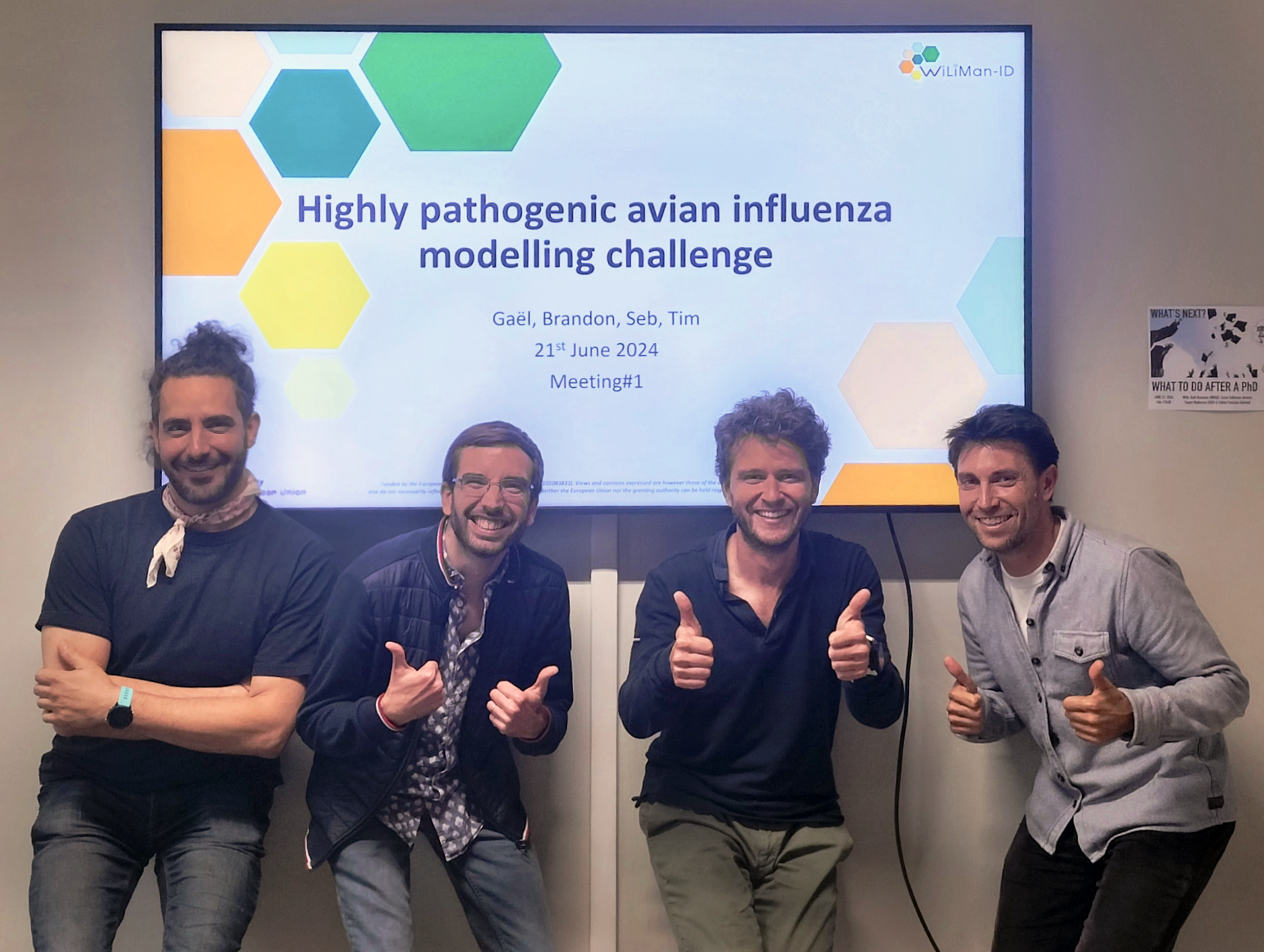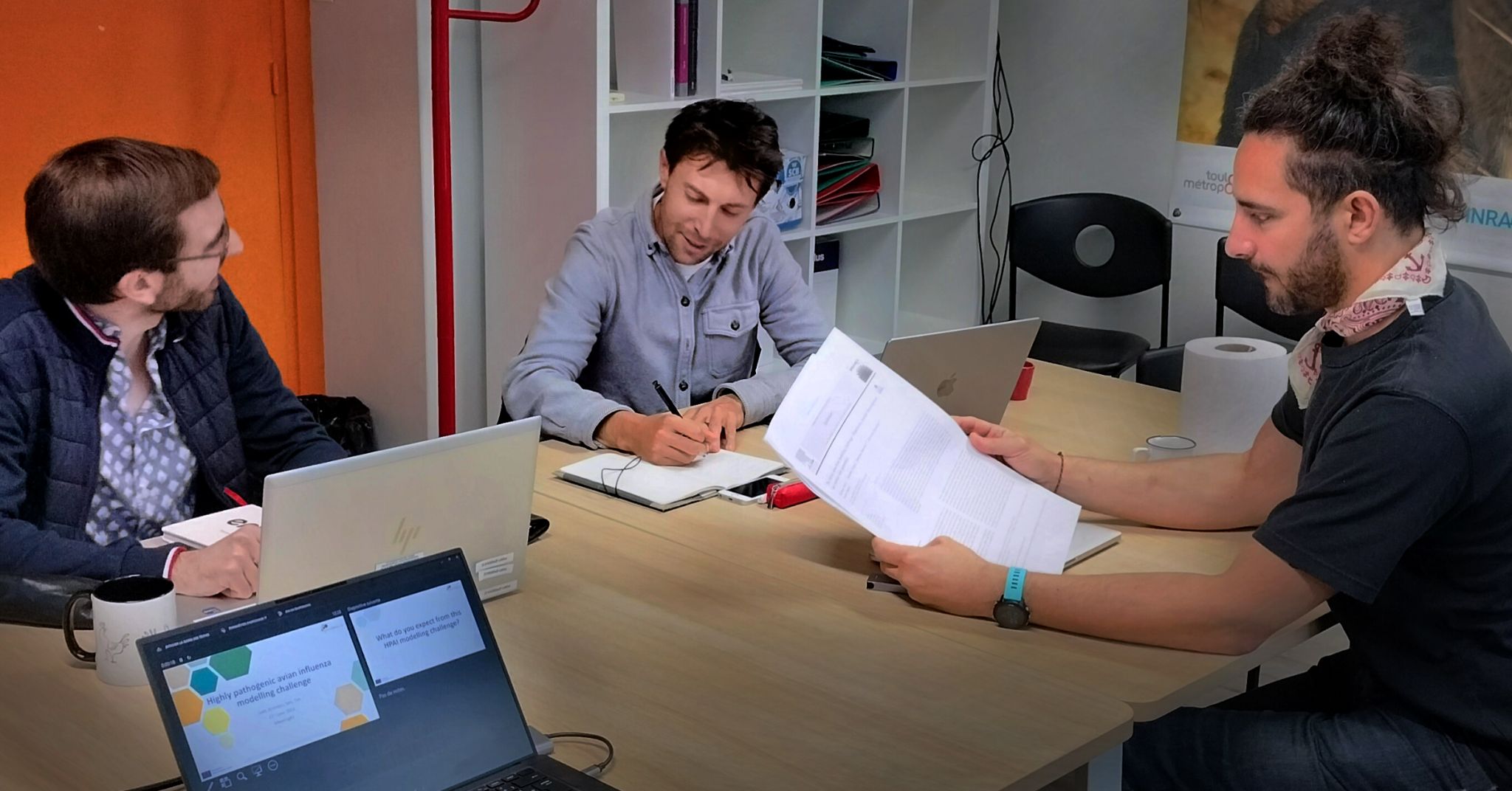
HPAI Modelling Challenge
Enhancing modelling capabilities for HPAI control through an international challenge
Highly Pathogenic Avian Influenza (HPAI) continues to pose significant threats to both farmed poultry and wild bird populations worldwide. The aim of this international challenge is to strengthen the ability of modelling teams to provide timely evidence-based insights that can inform policy decisions. Specifically, the challenge seeks to improve readiness when responding to emerging threats—such as Highly Pathogenic Avian Influenza (HPAI)—and to foster international collaborations between experts in the field.
Objectives of the modelling challenge
Improve outbreak modelling readiness: Equip modelling teams with practice scenarios that closely mimic HPAI dynamics at the interface between commercial poultry operations and wild bird populations.
Promote international collaboration: Foster a diverse community of researchers to exchange methods, tools and expertise, thereby improving global preparedness against emerging HPAI threats.
Evaluate intervention strategies: Encourage participants to test different control measures, forecast outbreak trajectories,and ass ess the efficacy of alternative interventions.
Facilitate knowledge sharing: Provide a platform to compare the performance of diverse modelling approaches, ranging from simple statistical methods to complex mechanistic frameworks.
Agenda
Preliminary timeline
- June 2025: Opening of applications (free participation)
- November-December 2025: Distribution of population data and mock HPAI data sets
- January 2026: Launch of challenge with kick-off meeting
- February 2026–April 2026: Challenge period, including distribution of official Challenge HPAI data
- May 2026–April 2027: Wrap-up phase
- June 2026 (tentative): Feedback workshop
During the challenge period
- The Coordinators will release updates of the evolving HPAI-like data sets to participating teams every month.
- The Players will provide summary statistics of predicted epidemic outcomes for the following set timeframe (likely once per month), as well as an assessment of the effectiveness of different intervention strategies.
- After three rounds of updates, the challenge will end.
During the wrap-up phase (6–12 months following the challenge)
- The Coordinators will analyse the results of the various modelling approaches that were used.
- The players may be contacted for additional information or clarifications.
- Insights from these analyses will form the basis for collective reporting and potential future publications.
- An online feedback workshop will be organised as a specific meeting. During this workshop, each team will present its model and the challenges it faced, while the Coordinators will provide an overview of the HPAI Challenge and the main lessons learnt.
How to participate
We welcome all modelling teams interested in joining this challenge. Please refer to the challenge rules for additional details. Although there are no strict prerequisites, an enthusiasm for modelling is highly encouraged!
Application process
To apply, complete the participation form with the following information:
- Team Name
- Name(s) of Team Member(s)
- Team Contact Email(s)
- Affiliation(s) of Each Player
- Short description of the team’s foreseen modelling approach (e.g., mechanistic vs. statistical, deterministic vs. stochastic, etc.)
- Motivation (briefly describe why your team is interested in this challenge)
Rules
Data
Participants will receive in silico data at regular intervals (schedule to be defined shortly) through a file transfer system. These datasets will contain the usual information necessary for modelling the spatio-temporal spread of avian infectious diseases, including:
- Land use details: Geographical layouts relevant to poultry farming and wild bird habitats.
- Host population characteristics: Information on commercial poultry operations and wild bird populations (e.g., flock types and sizes, geographical coordinates of the operations, etc.).
- Outbreak data: Distribution of reported HPAI out breaks over time and space, with associated outbreak characteristics.
- Laboratory results: Diagnostic outcomes and testing data.
- Control measures: A narrative description of the interventions implemented to control the epidemic (details to be finalised soon).
To simulate the data-poor conditions often experienced during real outbreaks, some aspects of the data will reflect a “fog of war”. For example, certain flock types might be underreported, or some outbreaks might be registered later than others. Comprehensive documentation explaining the dataset will be provided on this website.
A separate, detailed set of rules outlining the challenge process will also be released as soon as possible. Once available, these rules will be sent to all registered participants and posted on this website.
Model outcomes
On a regular basis (likely to be monthly), participants will be asked to use their models to provide:
- A reconstruction of past epidemic trends: Predict the spatio-temporal progression of the outbreak for previous weeks based on the data provided.
- A forecasting of future spread: Estimate how the outbreak may evolve in upcoming weeks.
- A comparison of intervention strategies: Prioritise a finite set of proposed control measures according to their effectiveness in containing or eradicating the HPAI-like epidemic.
Any type of model is welcome! Note that previous challenges have shown that simple statistical approaches can sometimes be more practical and better at predicting than complex mechanistic ones, depending on the context. Toward the end of the challenge, each team will submit a comprehensive description of its modelling method(s), ensuring transparency and reproducibility of results.
Coordinators’ role
- The Coordinators will analyse all submitted model outputs, knowing the “true epidemic”that underlied the in silico data.
- They will then prepare a summary document that synthesises key insights from the challenge and evaluates the performance of each participating modelling team.
- This summary will be circulated to all participants (and potentially shared more widely, depending on the challenge’s dissemination plan).
- They will coordinate the publication of an overarching scientific article or the edition of a special issue in a scientific journal to be defined.
Agenda
Participation
Rules
Preliminary timeline
- June 2025: Opening of applications (free participation)
- November-December 2025: Distribution of population data and mock HPAI data sets
- January 2026: Launch of challenge with kick-off meeting
- February 2026–April 2026: Challenge period, including distribution of official Challenge HPAI data
- May 2026–April 2027: Wrap-up phase
- June 2026 (tentative): Feedback workshop
During the challenge period
- The Coordinators will release updates of the evolving HPAI-like data sets to participating teams every month.
- The Players will provide summary statistics of predicted epidemic outcomes for the following set timeframe (likely once per month), as well as an assessment of the effectiveness of different intervention strategies.
- After three rounds of updates, the challenge will end.
During the wrap-up phase (6–12 months following the challenge)
- The Coordinators will analyse the results of the various modelling approaches that were used.
- The players may be contacted for additional information or clarifications.
- Insights from these analyses will form the basis for collective reporting and potential future publications.
- An online feedback workshop will be organised as a specific meeting. During this workshop, each team will present its model and the challenges it faced, while the Coordinators will provide an overview of the HPAI Challenge and the main lessons learnt.
We welcome all modelling teams interested in joining this challenge. Please refer to the challenge rules for additional details. Although there are no strict prerequisites, an enthusiasm for modelling is highly encouraged!
Application process
To apply, complete the participation form with the following information:
- Team Name
- Name(s) of Team Member(s)
- Team Contact Email(s)
- Affiliation(s) of Each Player
- Short description of the team’s foreseen modelling approach (e.g., mechanistic vs. statistical, deterministic vs. stochastic, etc.)
- Motivation (briefly describe why your team is interested in this challenge)
Data
Participants will receive in silico data at regular intervals (schedule to be defined shortly) through a file transfer system. These datasets will contain the usual information necessary for modelling the spatio-temporal spread of avian infectious diseases, including:
- Land use details: Geographical layouts relevant to poultry farming and wild bird habitats.
- Host population characteristics: Information on commercial poultry operations and wild bird populations (e.g., flock types and sizes, geographical coordinates of the operations, etc.).
- Outbreak data: Distribution of reported HPAI out breaks over time and space, with associated outbreak characteristics.
- Laboratory results: Diagnostic outcomes and testing data.
- Control measures: A narrative description of the interventions implemented to control the epidemic (details to be finalised soon).
To simulate the data-poor conditions often experienced during real outbreaks, some aspects of the data will reflect a “fog of war”. For example, certain flock types might be underreported, or some outbreaks might be registered later than others. Comprehensive documentation explaining the dataset will be provided on this website.
A separate, detailed set of rules outlining the challenge process will also be released as soon as possible. Once available, these rules will be sent to all registered participants and posted on this website.
Model outcomes
On a regular basis (likely to be monthly), participants will be asked to use their models to provide:
- A reconstruction of past epidemic trends: Predict the spatio-temporal progression of the outbreak for previous weeks based on the data provided.
- A forecasting of future spread: Estimate how the outbreak may evolve in upcoming weeks.
- A comparison of intervention strategies: Prioritise a finite set of proposed control measures according to their effectiveness in containing or eradicating the HPAI-like epidemic.
Any type of model is welcome! Note that previous challenges have shown that simple statistical approaches can sometimes be more practical and better at predicting than complex mechanistic ones, depending on the context. Toward the end of the challenge, each team will submit a comprehensive description of its modelling method(s), ensuring transparency and reproducibility of results.
Coordinators’ role
- The Coordinators will analyse all submitted model outputs, knowing the “true epidemic”that underlied the in silico data.
- They will then prepare a summary document that synthesises key insights from the challenge and evaluates the performance of each participating modelling team.
- This summary will be circulated to all participants (and potentially shared more widely, depending on the challenge’s dissemination plan).
- They will coordinate the publication of an overarching scientific article or the edition of a special issue in a scientific journal to be defined.
Organisers and participants
This initiative is organised by a dedicated coordination group (“The Coordinators”), targeting a wide range of international modelling teams (“The Players”). The Coordinators have generated in silico datasets that closely mimic the spread of an HPAI-like virus at the interface between commercial poultry operations and wild bird populations in a typical European setting. These datasets will be released incrementally over the course of an evolving virtual outbreak scenario, which will last approximately four months.

Expected outcomes
Enhanced modelling readiness: Participants will refine skills for rapidly analysing emerging threats.
Comparative analysis of models: A comprehensive overview of the strengths and weaknesses of different modelling techniques.
Evidence-based policy guidance: Insights on managing HPAI outbreaks, informed by collaborative analysis of simulated scenarios and direct engagement with policymakers to ensure relevance and effective communication.
Publication opportunities: A special journal issue or other dissemination avenues may be arranged to highlight the findings and innovations of the challenge. This publication would highlight the collaborative spirit and expertise of the participating teams while informing policy-making and scientific communities about effective HPAI control strategies.
Data distribution and modelling approaches
Data delivery : Synthetic data sets reflecting HPAI spread will be disseminated every month for four months, simulating a real-time outbreak scenario.
Model diversity : Participants are free to adopt any modelling framework they find suitable, be it simple statistical approaches or complex mechanistic models. Past experiences have shown that both types can offer valuable insights depending on the context.
Data example
Click here to download a provisional synthetic HPAI outbreak dataset, which will become available near the end of 2025.
Important note: The dataset available here is a preliminary example; it is not the final set of synthetic data that will be used in the challenge. During the challenge, participants will receive a dataset simulating a realistic scenario, closely matching the structure of this provisional file, though with different content.
Overview of previous modelling challenge
For an overview of the first modelling challenge in animal health, see the special issue on the African swine fever challenge, published in the journal Epidemics. For further information on modelling challenges focused on human health, refer to these associated publications for influenza, dengue, and Ebola virus.
This challenge is designed to be both rigorous and enjoyable, encouraging participants to collaborate, innovate, and share expertise. By combining diverse modelling approaches with real-time simulation data, we expect to foster the ability of modelling teams to quickly respond to HPAI-like epidemics, ultimately strengthening global response strategies for current and future outbreaks.
Contacts

For any additional questions or clarifications, please reach out to:
hpai-modelling-challenge-coordinators@groupes.renater.fr
You can follow news on Bluesky : #HPAIModChallenge
The Coordinators: Brandon Hayes, Sébastien Lambert, Gaël Beaunée, Timothée Vergne
